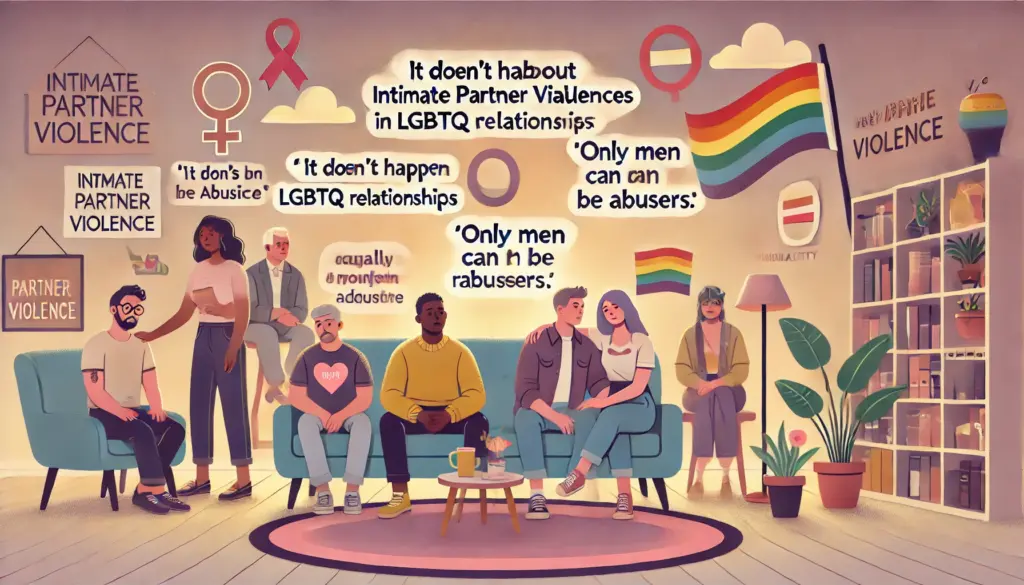
Myth 1 – Only straight women are victims of intimate partner violence. Men are not victims of intimate partner violence, and women never commit violence against their partners.
Such myths ignore the realities of same sex relationships. Men can be and are victims of intimate partner violence, and women can and do commit violence against their partners. Intimate partner violence is about power and control. Even when two people are of the same gender, power differences exist and can be abused.
Myth 2 – It really isn’t intimate partner violence when two gay men fight. It’s just boys being boys. A man should be able to defend himself.
These ideas grow out of a larger societal attitude and the primitive notion that it is acceptable for men to be violent; that it is normal and even appropriately masculine. There is nothing normal or appropriate about intimate partner violence. The vast majority of same-sex relationships are free of abuse. ‘Boys being boys’ may have been acceptable on the playground at age six, but when you are adult men with injuries inflicted by your partner, it is neither normal nor acceptable.
Myth 3 – The person committing violence is always bigger, stronger, and more “butch,” while victims are always smaller, weaker, and more traditionally feminine.
Experience with heterosexual battering and attitudes about traditional sex roles lead many to fall into stereotypes of how batterers and victims should look and act. Unfortunately, such stereotypes are of little actual use in helping us to identify who is committing violence and who is the victim in a same-sex relationship. A person who is small, but prone to violence and rage can do a lot of damage to someone who may be taller, heavier, stronger, and non-violent. Size weight, “masculinity”, “femininity” or any other physical attribute or role is not a good indicator of whether a person is a victim or a perpretator of violence, especially considering that intimate partner violence can include emotional, financial, and sexual abuse. A battere does not need to be tall and muscular to use a weapon against you, to smash your belongings, to cut up your clothing, or tell everyone at work that you really are “queer.”
Myth 4 – People who are abusive & under the influence of drugs or alcohol are not responsible for their actions.
Violence is a choice, and there are better choices. Every person is responsible for every action taken. Drugs and alcohol are excuses for battering. There is evidence to show that batterers who abuse drugs and alcohol are equally likely to batter while sober. If a person who batters is on drugs or alcohol, that person has two serious and very separate problems. Using drugs or alcohol does NOT relieve a person of responsibility for his/her own conduct.
Myth 5 – The law does not and will not protect victims of violence in the LGBTQ community.
It depends somewhat on where you live, but in the United States, heterosexuality is not a criterion for protection under the law. California State domestic violence laws protect LGBTQ individuals from being abused by their partner. LGBTQ victims can get restraining orders. Domestic violence is against the law for LGBTQ people.
Myth 6 – Domestic violence occurs primarily among gay men and lesbians who hang out at bars, are poor, or people of color.
Domestic violence is a non-discriminatory phenomenon. Batterers come from all walks of life, all racial/ethnic groups, all socioeconomic strata, and all educational levels. The LGBTQ community includes members of every other minority and majority group (ethnic, religious, racial, socioeconomic, immigration status, etc) Domestic violence occurs proportionally across all groupings and categories of people. No group is exempt.
Myth 7 – It is easier for lesbian or gay victims of domestic violence to leave abusive relationships than it is for heterosexual counterparts who are married. If it were really that bad, they would just leave.
Lesbian and gay couples are as intertwined and involved in each others’ lives as are heterosexual couples. Due to the lack of societal support many lesbians & gay men are more “protective” of the relationship and less likely to leave despite the abuse. Leaving is often the hardest thing for a victim to accomplish—harder for instance than staying. Batterers threaten their victims with more violence (including threats of murder) if they leave. Threatening to leave may put the victim in more danger. Leaving also requires strength, self-confidence, self-reliance, and a healthy self esteem. Those qualities have been eroded by the abuse. Leaving a violent partner also mean leaving one’s home, friends, children and community. A lesbian or gay man may be extremely isolated. Because it is assumed that programs specific to helping LGBTQ victims do not exist, it may be more difficult to leave the abusive relationship.
Myth 8 – Lesbian and Gay domestic violence is the same as domestic violence between a man and a woman.
The dynamics of same gender relationships are not the same as in heterosexual relationships. The stresses of being without full legal protections and the lack of societal support for their relationships are added stresses for the lesbian or gay relationship. Therefore, lesbians and gay men will not respond to stress in their relationship the same way as heterosexual individuals do. Lesbian relationships and gay men’s relationships will not look like nor respond to stress & abuse within the relationship the same way as heterosexual relationships.